
According to various estimates, the amount of space debris in Earth's orbit varies from 220 to 300 thousand objects. At the same time, objects with a diameter of more than 1 cm make up from 20 to 33% (from 60 thousand to 100 thousand) of all space debris. Just imagine what effect an "astronomical bullet" can have on a spaceship passing by. Of course, on the scale of our orbit, this seems insignificant, but according to scientists, after 2055, as a result of the mutual self-destruction of debris already in orbit, the problem of space debris will become a serious obstacle to further space exploration. Now more about this and other possible consequences.
The essence of the problem
Physical threat
Actually, the most obvious threat from space debris is the threat of a physical collision. At the current level of technology development, there is no way to protect spacecraft from a small object, the size of a bullet, moving at a speed of 10 km / s. Well, there is no need to stutter about protection from larger objects, although there are significantly fewer of them in orbit. In addition to the threat of damage and destruction of objects launched from Earth, there are a huge number of different satellites in orbit, which are necessary for the operation of various services. GPS, meteorology, and a lot of things in general. Destroying one of them will not make the entire system unviable, but in the face of an increase in the amount of garbage in the future, this can seriously affect the performance of these systems. Apart from predictions for the future,in the present and in the past there are examples of collisions of spacecraft with debris:
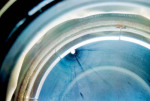
During the entire time of the shuttle program, they found about 170 traces on the windows from the collision, fortunately with microparticles (0.2 mm in diameter). About 70 windows were replaced. The image on the left shows a 2.5 mm crater from a paint particle.
- In July 1996, a French satellite collided with the third stage of the French Arian rocket, launched much earlier;

French rocket Arian. Source - ESA
- On March 29, 2006, the Russian Express AM11 satellite collided with space debris. As a result of the collision, the thermal control system was depressurized, the satellite lost its orientation and began an uncontrolled rotation.
- On February 10, 2009, the Russian satellite Kosmos-2251, decommissioned in 1995, collided with the American commercial satellite Iridium 33.
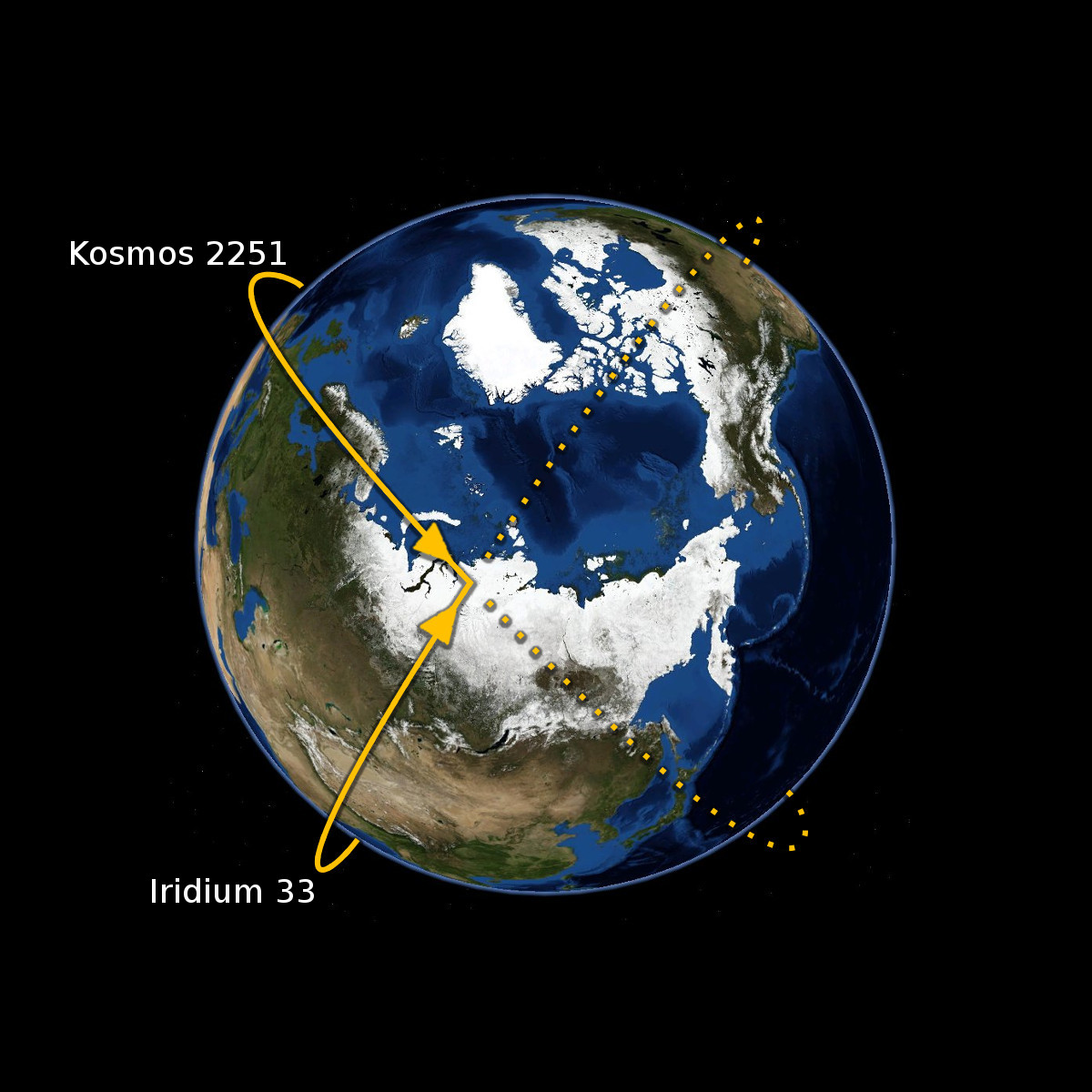
Collision of Cosmos-2251 and Iridium 33. Source - vermarushabh.blogspot.com
To control debris, space agencies maintain appropriate registers that track relatively large (from a few centimeters) objects. For example. Based on the available data, the ISS adjusts its position in orbit several times a year in order to avoid a collision.
Kessler syndrome
In addition to the threat of physical destruction, space debris can be the reason for the complete unsuitability of near space for practical use. This theory is described by the so-called Kessler syndrome, described by NASA consultant Donald Kessler in 1978. The essence of this theory lies in the "domino effect". As the number of objects in orbit increases, so does the number of potential debris sources. The collision of two large objects will result in a large number of new, smaller objects. In turn, each of them can collide with another object. Thus, a "chain reaction" arises, leading to the appearance of more and more debris. As a result, with a sufficiently large number of collisions, the amount of generated debris in orbit will make it impossible to use it.
However, in low orbits, interaction with the atmosphere gradually reduces the amount of debris, and this brings us to the next threat.
The fall of space debris to Earth
Objects in low orbit are still under the influence of the earth's atmosphere and gradually slow down, as a result, after some time, they begin to decline and enter the denser layers of the atmosphere. Many objects burn up in the atmosphere, but there are also those that reach the surface of the planet. So, according to NASA, almost every year, separate fragments of spacecraft reach the Earth's surface.

Source - oyla.xyz
Spaceship graveyard
Point Nemo is the farthest from land on Earth, also called the oceanic pole of inaccessibility. The Pole of Inaccessibility is the most difficult location to reach due to its remoteness, usually from the coastline. The nearest land is 2688 kilometers from Point Nemo, and the nearest populated place is periodically the ISS, which orbit passes over this place. Its low nutrient content (the South Pacific cycle blocks nutrients from reaching the area) and its distance from coastal waters make the site virtually lifeless, making Point Nemo an ideal burial site for spacecraft. From time to time this area is called the cemetery of spaceships. Some Russian-speaking sources call this area closed to navigation,but judging by the lack of regulatory documents and regulations on the burial procedure (about which a little below), this prohibition is advisory in nature. Chile and New Zealand share responsibility for the movement of ships in this region. A few days before the descent of the spacecraft, space agencies warn the services of these countries, which, in turn, convey appropriate warnings to avoid this area to the pilots and captains of ships.which, in turn, convey appropriate warnings to avoid the area to the pilots and captains of ships.which, in turn, convey appropriate warnings to avoid the area to the pilots and captains of ships.
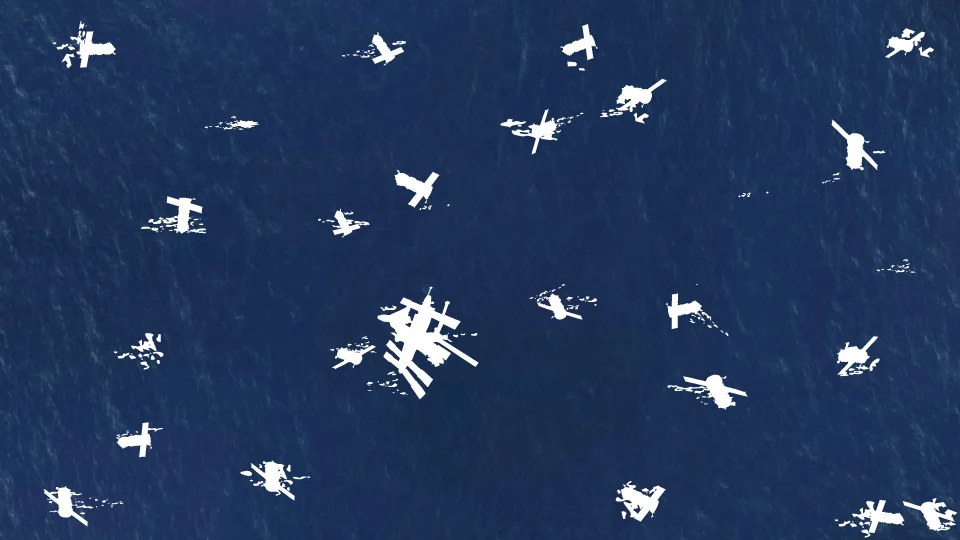
— gizmodo.com
As with any other space operation, the disposal of a spacecraft requires appropriate preparation. After carrying out the necessary calculations and warning the local authorities, the device, having reached the required location, starts braking. As mentioned above, small and compact satellites, as a rule, do not reach the earth's surface and are burned up by friction. Various refractory structures reach the surface of the water. For example, this section is used by the Russian Mission Control Center for the disposal of space unmanned trucks of the Progress series. By the way, as a result of burial, parts of the spacecraft can scatter over a large area. So, for example, the remains of the Mir station, flooded in 2001, scattered over a stretch of 3,000 kilometers.A similar feature several times became the cause of the emergency. In 1979, part of the American Skylab station fell on the territory of Australia, in 1991 the wreckage of the Salyut-7 station fell on the territory of Argentina. Also in 1997, an unburned part of a rocket fell on a woman in Oklahoma. Fortunately, all of these cases happened without casualties. Now, every year, several dozen ships find their last refuge in the cemetery of spaceships, which, being in orbit, are a source of greater threat.Every year, several dozen ships find their last refuge in the cemetery of spaceships, which, being in orbit, are a source of greater threat.Every year, several dozen ships find their last refuge in the cemetery of spaceships, which, being in orbit, are a source of greater threat.
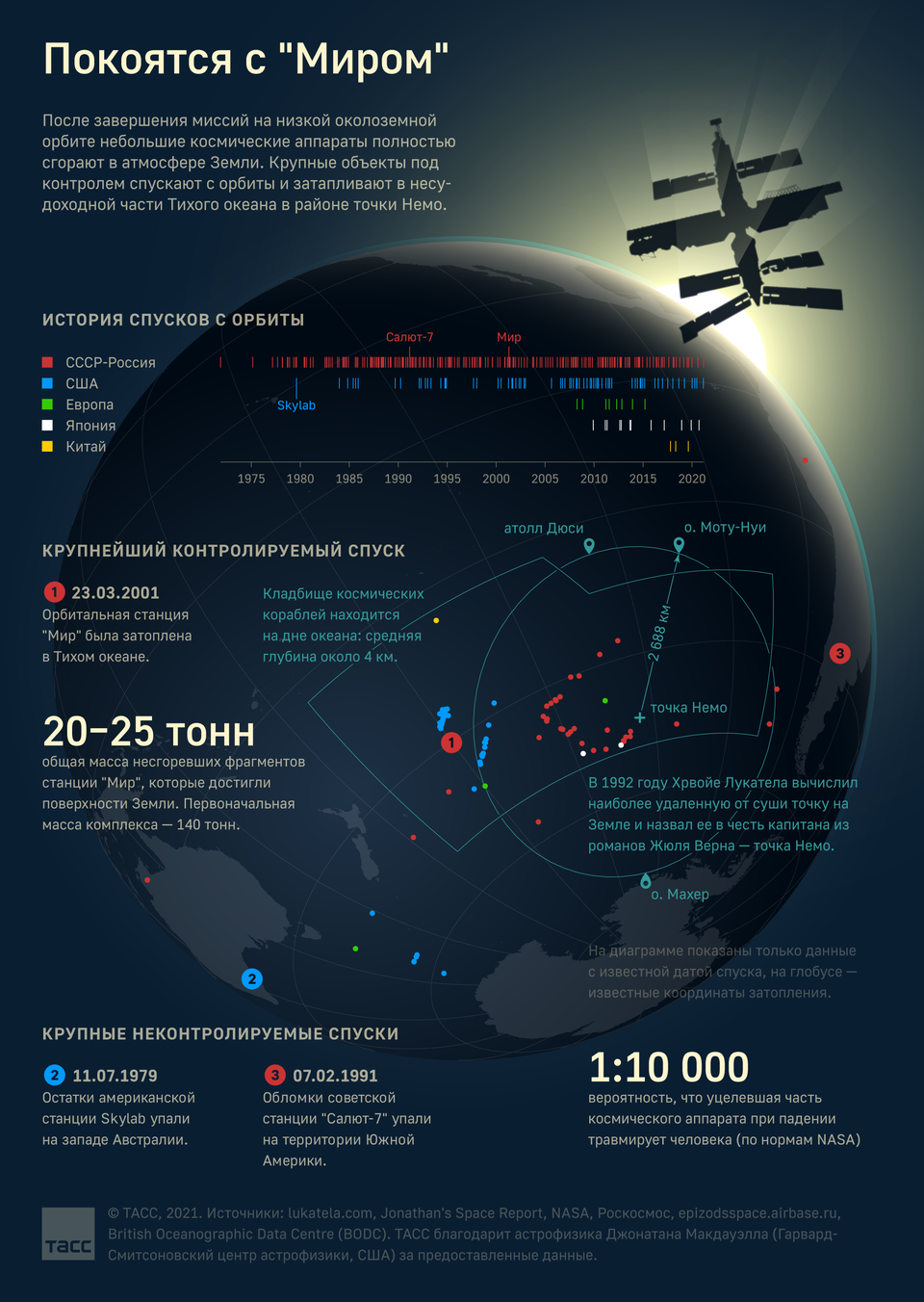
TASS infographics. Source - tass.ru
Burial orbit
In addition to the ground cemetery, there is also an orbit into which already spent spacecraft are sent to reduce the likelihood of collisions with those still working. There are two official disposal orbits: for spacecraft in geostationary orbit and for nuclear powered military reconnaissance satellites.
A geostationary orbit is an orbit located above the equator of the earth, in which an artificial satellite has the same angular velocity as the earth, i.e. is always over the same place on Earth. This orbit is used to host communication, television broadcasting satellites and is located at an altitude of 35,786 kilometers above sea level. After working off, the satellite is about 200 km (for each satellite the distance is calculated individually).
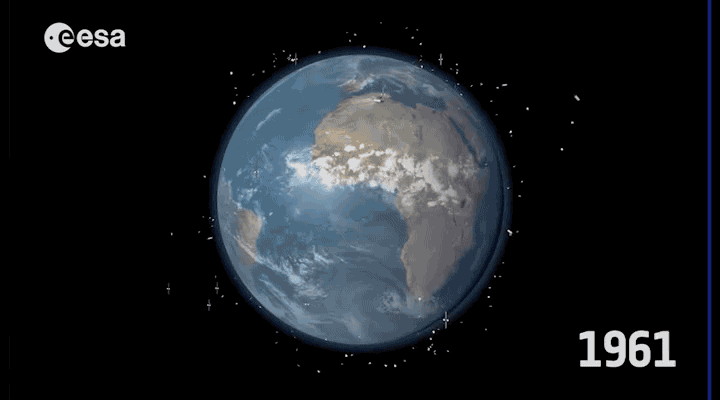
An increase in the number of artificial satellites of the Earth. Source - European Space Agency.
Another burial orbit is at an altitude of 600 to 1000 kilometers. Military satellites with a nuclear power plant are sent into this orbit. Tentatively, these satellites will be in orbit for about 2 thousand years, after which the Earth's gravity will pull them in.
Solutions
In general, finding ways to solve this problem is no different from solving the problem of creative clutter on your desk, only the scale of the former is slightly larger. There are two ways - create less trash or clean up the old one.
Reduced waste generated
As the saying goes, "It's clean not where they clean up, but where they don't litter!" Actually, this is the point. The main directions for reducing the generated waste include the following measures:
- Reducing the mass of the launched vehicle:
Less weight means less potential waste. It's simple.
- Extending the service life of spacecraft:
The longer satellites operate, the fewer replacement flights will be made.
- Minimizing the number of spacecraft parts remaining in outer space:
Disposal of spent parts and the spacecraft itself, or returning parts back to Earth.
As you can see, the first two points intersect with the general directions of the development of astronautics. The last point, however, makes some adjustments to the construction of missiles. How to properly organize the disposal of used parts? One of the developing directions is the use of materials that allow launch vehicles to put the device into orbit and then burn up in the atmosphere. Those. such material must withstand all take-off loads, and at the same time must not be super refractory to burn out in the atmosphere due to friction. Sounds like a kind of paradox. At the moment, there are no such materials in rocketry.
The second way is the return of the spacecraft parts to the Earth. The most obvious examples are SpaceX's reusable stages and the Space Shuttle program.
Disposal of existing garbage
Unlike the vehicles designed with the idea of recycling, the debris in orbit cannot utilize itself. All current projects to "clean up" space debris are either in development or in the form of an idea. Many ideas were voiced, which can be classified as follows:
- Lasers
The bottom line is to destroy debris with a laser. Well, that sounds fantastic.
- Capture
Capture debris with a heavy-duty net and send it into the dense atmosphere. By the way, in 2019, the British apparatus RemoveDebris was able to capture a fragment of the satellite.
- Balloons
A large ball should wrap around the debris, while increasing their resistance and accelerating the process of entering the dense layers of the atmosphere.
- Solar sail tug
A solar sail is a device that uses the pressure of light to propel a spacecraft. As planned, such a device will cling to debris and take it out of orbit.
- Tungsten cloud
As planned, the tungsten cloud will slowly descend towards the Earth, simultaneously slowing down the debris.
- Suicide machines
Such a device should literally push dangerous objects into the atmosphere, and at the same time also go out of orbit.
- Orbital garbage trucks
The device will collect debris in orbit and process it.
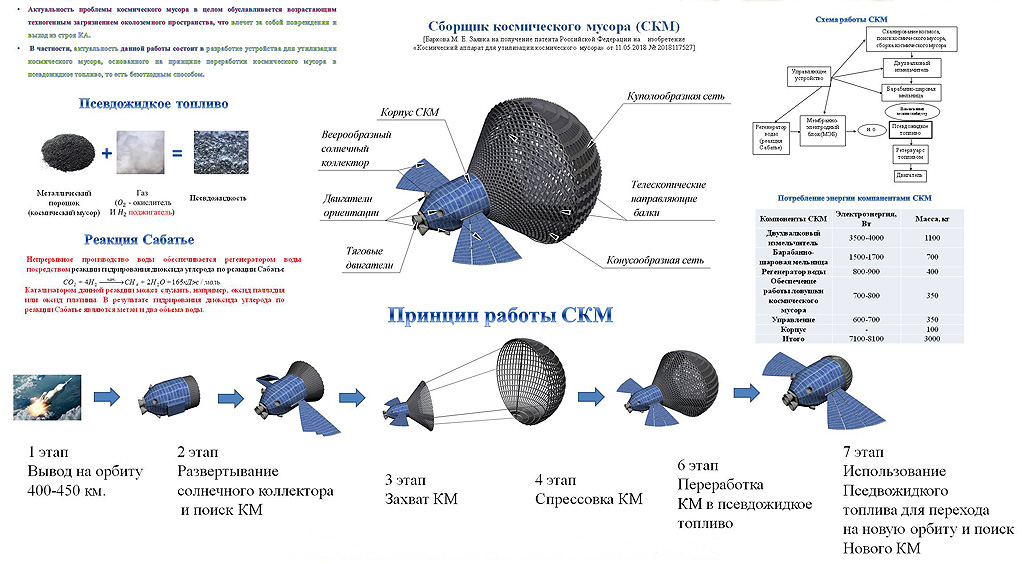
A Russian space debris collector that recycles space debris into fuel. Source - russianspacesystems.ru
Cloud servers from Macleod are fast, secure and don't generate space junk.
Register using the link above or by clicking on the banner and get a 10% discount for the first month of renting a server of any configuration!
